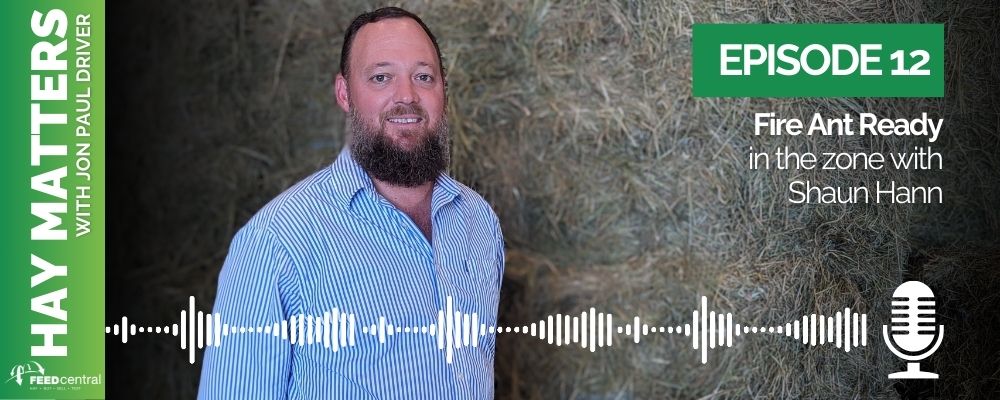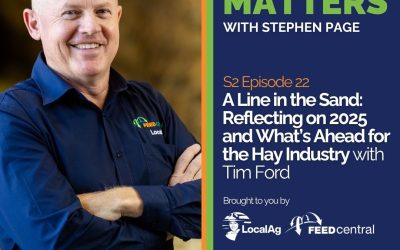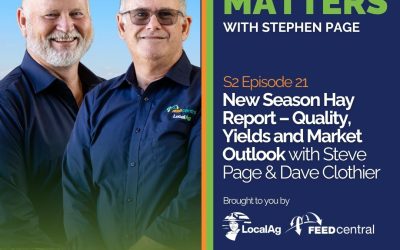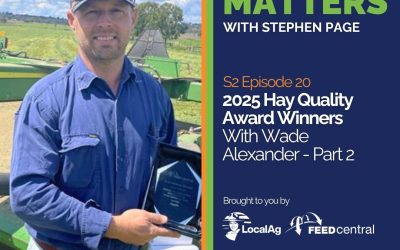
This week on the podcast, Jon Paul Driver sits down with Shaun Hann, the Manager at Toowoomba Hay Farm, to discuss his firsthand experiences after one of their storage facilities was declared to be in a fire ant zone. Shaun shares how this unexpected challenge has impacted their operations, the new regulations they are navigating, and the practical steps they are taking to remain fire ant free and compliant.
Episode Highlights:
- The recent discovery of fire ants just kilometres away from Toowoomba Hay Farm’s Oakey storage facility has necessitated a rapid educational and operational response to comply with stringent biosecurity standards.
- Fire ants, known for their destructive impact on crops and painful stings, represent a significant agricultural and public health threat.
- Following the identification of a fire ant nest in May, a five-kilometre contamination zone was established around the nest site, placing Toowoomba Hay Farm’s Oakey storage facility within this high-alert area.
- Fortunately, Toowoomba Hay Farm’s storage facilities already had bitumen and concrete flooring, but has taken additional biosecurity measures, including setting up chemical barriers and updating storage protocols, to prevent the spread of ants.
- Staff at the facility underwent extensive training and received certifications in fire ant management, ensuring preparedness and compliance with the National Fire Ant Eradication Program and Queensland’s Biosecurity 2016 guidelines.
- Toowoomba Hay Farm has adopted additional safety protocols, including weekly inspections and advanced pest control treatments, to proactively exceed governmental requirements.
- The ongoing government-led baiting and chemical treatments aim to reduce the spread of the ant colonies, with the storage facility’s status remaining in Zone One, indicating continued high vigilance and control efforts.
- The potential downgrade of the contamination zone from Zone One to Zone Two remains uncertain, which could impact future plans and costs.
Visit the Feed Central Fire Ant Resource Page for helpful tips on biosecurity, along with training and certification resources compiled by the team after their experience in a fire ant zone.
Read Transcript
Jon Paul Driver 0:05
Welcome to the Feed Central Hay Matters podcast, your go-to source for all things hay related in Australia. I’m your host Jon Paul Driver. In today’s episode, we’re joined by Shaun Hann. Shaun’s the Toowoomba Hay Farm Manager for Feed Central. Welcome to the podcast.
Shaun Hann 0:20
Thanks JP.
Jon Paul Driver 0:20
Today we’re talking about fire ants. I’m the perfect one to ask the dumbest questions. Because I know nothing about fire ants. I live in a place that has real winters, so we don’t have them. And I understand you’ve gone through quite the learning process in managing through fire ants. Where do we start?
Speaker 1 0:40
We’ve had a very steep learning curve, we’ve been lucky to date that we’ve been quite removed from the fire ant infestation on the east coast of Australia. We’ve been far enough away for a long time now that it hasn’t really had any impact, we’ve not had to worry. But a recent discovery within a couple of kilometres of our Oakey storage facility has meant we’ve had to very quickly get up to speed.
Jon Paul Driver 1:04
So I was there in August of ’23. And I don’t remember much discussion about fire ants, just that it’s a possibility on the occasion. Not to get too technical. But what’s the problem with fire ants?
Shaun Hann 1:17
The problem we’ve got with fire ants, because they’re introduced pest species, and they do significant damage to crops, and they’re obviously not nice for people.
Jon Paul Driver 1:27
Yeah, the name doesn’t sound good.
Shaun Hann 1:29
Yeah, that’s right. They’ve got a sting similar to that of a bee from their abdomen. So it’s not like when I say standard the normal ant that bites you. Yeah, it’s, it’s actually a stinging ant. So. Okay. It’s quite painful. And from my understanding, thank goodness, I haven’t been stung myself, but from watching other videos of people who’ve had some dealings with them. It is like a fire burning feeling once it’s done.
Jon Paul Driver 1:55
Wow. So there’s been… is outbreak the right word?
Speaker 1 1:59
Yeah, I guess a new outbreak in a new area. So the way the Queensland Department of Agriculture and Fishery approaches it is once they have a reported nest and do an investigation, they create the five-kilometer radius around that zone, which is what they deem to be the contaminated area. And then they go to investigating, searching, treating, and that sort of thing. But yeah, effectively, if you’re within that five-kilometer radius of that nest, you then become part of a fire ant zone.
Jon Paul Driver 2:29
How long have you been in the fire ant zone?
Speaker 1 2:31
We had this happen in late May, we were designated a fire ant zone, had to put everything in place, create biosecurity documents, work with the National Foreign Eradication Program, inspectors from the Department of Agriculture, and Fisheries, get up-to-date, do the learnings, work to the Queensland Government Biosecurity 2016 guidelines, put in biosecurity control measures, really, really quickly get up to speed so that we can be compliant and be on the forefront on the front foot with all the requirements and then work to exceeding those requirements so that we can give our customers some confidence that we’re doing everything we need to plus more.
Jon Paul Driver 3:12
And what are some of those measures?
Speaker 1 3:15
I think a minimum from our understanding from working to the legislation would be concrete floors or bitumen floors in storage sheds, chemical barriers, you can have a 200 micron plastic put down then a chemical barrier or off-ground storage. There’s lots of different bits and pieces when around hay production and from time of cutting, to raking, to baling to putting into storage to try and prevent fire ants contaminating that crop in that harvest.
Jon Paul Driver 3:45
The worst outcome would be to have an infestation and then have it transported somewhere else and be part of the problem.
Speaker 1 3:50
And then move it, 100%. And that was our main concern because we’re very lucky that none of our farms that have been procured in the last 12 to 18 months are inside the fire ant zone. So we’re not producing any hay inside the fire ant zone. We just have a storage facility that happened to land inside that five-kilometer radius. We’re also very lucky that it’s completely enclosed. Bitumen floors, plastic down as an extra which we were doing to help with moisture into those bottom bales it wasn’t fire ant related at the time, but it’s proved to be very, very good measure for that as well. And then we just had to quickly get our local pest control company to come in using the correct chemicals specified by the Queensland Government to create that chemical barrier around the shed as well. We’ve got our staff up to speed, done the online training, got them through the fire ant course, got them certified as completed and then put in some other things such as using our Safe Ag system to record weekly inspections, which is above and beyond anything that we’re required to do, but it’s just one of those things that we’ve though, while we’re doing it, let’s put some policies and procedures in place that outstrip the requirements of the Government, so that we can show we’re really taking it seriously and doing everything we can to be on top of the problem.
Speaker 1 3:51
Great. That sounds like a very proactive approach.
Jon Paul Driver 4:24
And that’s what we’re trying to do. Because I know, we don’t want to be part of the problem. Like you said, we’d hate to be responsible for having a product, transporting it, and then being found that it had a fire ant contamination that we’ve been part of that spread. From a personal perspective and a business perspective, we just want to do everything we can to be 100% on the forefront and doing more than we have to, so that we can say we’re taking the absolute most measures we can commit to, to prevent that.
Now what comes next? Do they have any timelines for you, as to when that fire ant zone won’t be a problem anymore?
Shaun Hann 5:49
There’s no real clear indication of if it will ever be removed, I’m not sure how that works, if it can be… from our understanding that it can possibly be downgraded from a zone one to a zone two. But at the moment, we’re in zone one, which is discovery of nest sites and being treated within a certain timeframe. So I think we’ll be on that path for a fair amount of time, while they use the baiting programs that they’ve got in place that the government is utilising, as well as the chemical treatment and nests, and go through the process of helping break down that colony and try and rid the area of it.
Jon Paul Driver 6:28
So, ongoing efforts.
Shaun Hann 6:31
Yeah, always ongoing, I think the best, probably the best way forward is just to continue irrespectively. Kit out our sites, kit out our storage facilities as if we have the problem, we’re very lucky most of our storage sheds have got concrete or bitumen floors, all sides enclosed, if not most sides enclosed. So we’re very lucky to have such good storage and farm facilities that put us in a good position to deal with the legislation to start with. I guess we’re just going to make every effort from here forward to be on the forefront and be open and transparent and honest with our customers, take them along the journey that we’ve come along, help people where we can help them if they’re feeling overwhelmed, because it was a big thing to deal with, on such a short timeframe, when effectively from the day they zoned us fire ant zone one, we had to stop trading, we had half a million dollars, couple hundred ton of product in a storage shed, we had contracts to go out, we’d committed to clients that we’d do deliveries. But we couldn’t move that product until we had met all the legislation and then gone through, had an inspector come and inspect and deem us compliant, you know for someone coming into that from the outside, it’s a lot to learn and, and when you’ve got financial commitments and customer commitments riding on it, it’s good to be able to share that knowledge with the industry, anyone who wants some help or wants to talk through it, which is predominantly why we’d like to do this today and and continue down that path to helping people as well as doing everything we need to I suppose.
Jon Paul Driver 7:59
Are there resources available through Feed Central to deal with fire ants specifically?
Shaun Hann 8:05
We’re currently in the process of creating a landing page on the Toowoomba Hay Farm website where we can help other people, maybe just those important links, how to find the information quickly. Where to get certification, the training, how to find the biosecurity documents and pull that information out of what can sometimes be a challenging web platform to get it all out. So yeah, we’re working on that at the moment.
Jon Paul Driver 8:30
If somebody does run into this problem that you’ve had, can they reach out?
Shaun Hann 8:34
100% I’m more than happy to help anyone industry-based or not, that would like to have a chat and go over the information. And we’re by no means the experts but having gone through it, I can definitely feel for people that have ended up in the same position, looking for someone just to talk through where to start or who to speak to, we got very lucky to have a quite a good inspector in the area Matt Larry that we work with from Department of Agriculture and Fishery, he was exceptionally helpful. So we’re happy to put people in contact with him. And I’m sure he’s happy to chat to everyone as well.
Jon Paul Driver 9:08
Good deal. Sounds like you have some great resources and you’re willing to share and help others along the way. You’ve survived the crisis mode and now that you’re managing it and willing to help others.
Shaun Hann 9:19
Thank you. We’ve been very lucky, very good team of supporters and some good industry professionals. So they got on board pretty quickly.
Jon Paul Driver 9:26
I want to say thank you for your thoughts today. I think this is a great story to tell. Certainly in agriculture we’re not alone when it comes to these crisis moments and rules and regulations and systems that you have to learn really quick.
Shaun Hann 9:39
For sure.
Jon Paul Driver 9:39
Again, we’ve been joined by Shaun Hann. He’s the Toowoomba Hay Farm Manager. What’s the website, Shaun?
Shaun Hann 9:46
It’s toowoombahayfarm.com.au
Jon Paul Driver 9:48
Simple enough. I suspect you’ll be able to go to that and find the resources and certainly I bet you if you call into the Toowoomba Hay Farm, they’ll be able to help you too. This podcast is proudly presented by Feed Central, stay tuned in for upcoming episodes.



